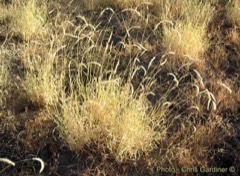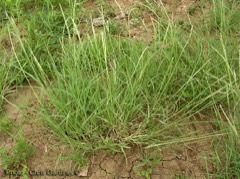 |
|
Chris Gardiner lucidcentral.org |
 |
| Chris Gardiner lucidcentral.org |
Translate this page:
Summary
Erect, shortly rhizomatous perennial, to 1.5 m high. Astrebla is a small genus of xerophytic (requiring little liquid water) grasses found only in Australia. They are the dominant grass across much of the continent distributed in Western Australia, Northern Territory, South Australia, Queensland, New South Wales. Sometimes misspelt as Astrebla aquamosa
Physical Characteristics

 Astrebla squarrosa is a PERENNIAL growing to 1.5 m (5ft) by 0.1 m (0ft 4in) at a fast rate.
Astrebla squarrosa is a PERENNIAL growing to 1.5 m (5ft) by 0.1 m (0ft 4in) at a fast rate.
See above for USDA hardiness. It is hardy to UK zone 10.
Suitable for: light (sandy), medium (loamy) and heavy (clay) soils, prefers well-drained soil and can grow in heavy clay and nutritionally poor soils. Suitable pH: mildly acid, neutral and basic (mildly alkaline) soils. It cannot grow in the shade. It prefers dry or moist soil and can tolerate drought. The plant can tolerates strong winds but not maritime exposure.
UK Hardiness Map
US Hardiness Map
Synonyms
No synonyms are recorded for this name.
Plant Habitats
Edible Uses
Edible Parts: Seed
Edible Uses:
Carbon Farming Solutions - Staple Crop: balanced carb (The term staple crop typically refers to a food that is eaten routinely and accounts for a dominant part of people's diets in a particular region of the world) [1-1]. Cultivated in the past but largely or completely abandoned.
References More on Edible Uses
Medicinal Uses
Plants For A Future can not take any responsibility for any adverse effects from the use of plants. Always seek advice from a professional before using a plant medicinally.
None Known
References More on Medicinal Uses
The Bookshop: Edible Plant Books
Our Latest books on Perennial Plants For Food Forests and Permaculture Gardens in paperback or digital formats.

Edible Tropical Plants
Food Forest Plants for Hotter Conditions: 250+ Plants For Tropical Food Forests & Permaculture Gardens.
More

Edible Temperate Plants
Plants for Your Food Forest: 500 Plants for Temperate Food Forests & Permaculture Gardens.
More

More Books
PFAF have eight books available in paperback and digital formats. Browse the shop for more information.
Shop Now
Other Uses
Providing habitat for organisms such as mammals. Bull Mitchell grass is less palatable to livestock than other Mitchell grasses. It can withstand grazing and drought and produces an abundance of fodder.
Special Uses
Carbon Farming
References More on Other Uses
Cultivation details
Historic Crop Management: Standard Staple Crop: Balanced carb
Climate: subtropical to tropical. Humidity: semi-arid. Grow on clay soils, mainly between an upper limit of 600 mm average annual rainfall, and a lower limit of 200 mm, and even below in depressions where the water concentrates following rains e.g. in Sturt's Stony Desert. Often seen growing to 1.5 metres tall on floodplains and heavy dark clay soils in arid to semi-arid Australia. The coarse stems and difficult digestibility make this a less desirable Mitchell grass for livestock. Mitchell grasses are deep-rooted and become dormant during drought, allowing them to survive extended periods without rainfall. Carbon Farming Solutions - Cultivation: historic crop. Cultivated in the past but largely or completely abandoned. Management: standard (Describes the non-destructive management systems used in cultivation) [1-1].
Carbon Farming
-
Historic Crop
These crops were once cultivated but have been abandoned. The reasons for abandonment may include colonization, genocide, market pressures, the arrival of superior crops from elsewhere, and so forth.
-
Management: Standard
Plants grow to their standard height. Harvest fruit, seeds, or other products. Non-Destructive management systems.
-
Staple Crop: Balanced carb
(0-15 percent protein, 0-15 percent oil, with at least one over 5 percent). The carbohydrates are from either starch or sugar. Annuals include maize, wheat, rice, and potato. Perennials include chestnuts, carob, perennial fruits, nuts, cereals, pseudocereals, woody pods, and acorns.
References Carbon Farming Information and Carbon Sequestration Information
Temperature Converter
Type a value in the Celsius field to convert the value to Fahrenheit:
Fahrenheit:
The PFAF Bookshop
Plants For A Future have a number of books available in paperback and digital form. Book titles include Edible Plants, Edible Perennials, Edible Trees,Edible Shrubs, Woodland Gardening, and Temperate Food Forest Plants. Our new book is Food Forest Plants For Hotter Conditions (Tropical and Sub-Tropical).
Shop Now
Plant Propagation
Wild. Seed.
Other Names
If available other names are mentioned here
Bull Mitchell grass, Mitchell grass
Native Range
AUSTRALASIA: Australia (New South Wales, Queensland, Western Australia, Northern Territory)
Weed Potential
Right plant wrong place. We are currently updating this section.
Please note that a plant may be invasive in one area but may not in your area so it's worth checking.
None Known
Conservation Status
IUCN Red List of Threatened Plants Status : This taxon has not yet been assessed

Growth: S = slow M = medium F = fast. Soil: L = light (sandy) M = medium H = heavy (clay). pH: A = acid N = neutral B = basic (alkaline). Shade: F = full shade S = semi-shade N = no shade. Moisture: D = dry M = Moist We = wet Wa = water.
Now available:
Food Forest Plants for Mediterranean Conditions
350+ Perennial Plants For Mediterranean and Drier Food Forests and Permaculture Gardens.
[Paperback and eBook]
This is the third in Plants For A Future's series of plant guides for food forests tailored to
specific climate zones. Following volumes on temperate and tropical ecosystems, this book focuses
on species suited to Mediterranean conditions—regions with hot, dry summers and cool, wet winters,
often facing the added challenge of climate change.
Read More
Expert comment
Author
C.E.Hubb
Botanical References
Links / References
For a list of references used on this page please go here
Readers comment
| Add a comment |
|
If you have important information about this plant that may help other users please add a comment or link below. Only comments or links that are felt to be directly relevant to a plant will be included. If you think a comment/link or information contained on this page is inaccurate or misleading we would welcome your feedback at [email protected]. If you have questions about a plant please use the Forum on this website as we do not have the resources to answer questions ourselves.
* Please note: the comments by website users are not necessarily those held by PFAF and may give misleading or inaccurate information.
To leave a comment please Register or login here All comments need to be approved so will not appear immediately.
|
Subject : Astrebla squarrosa
|
|
|
|